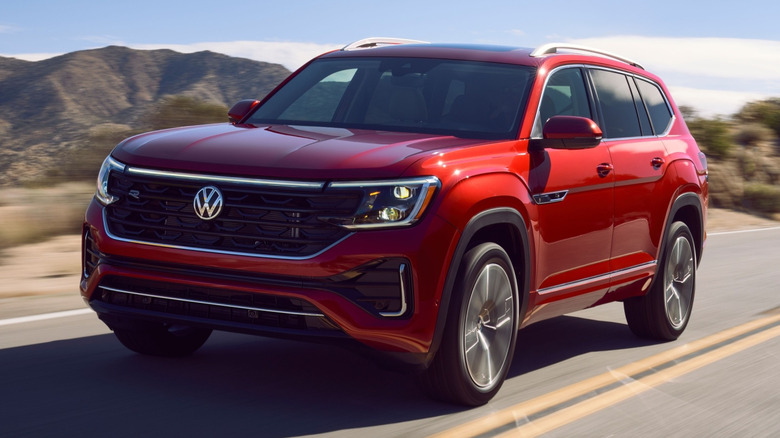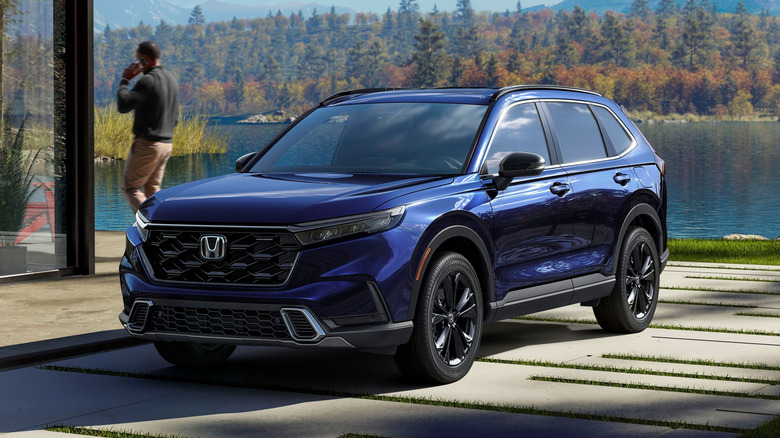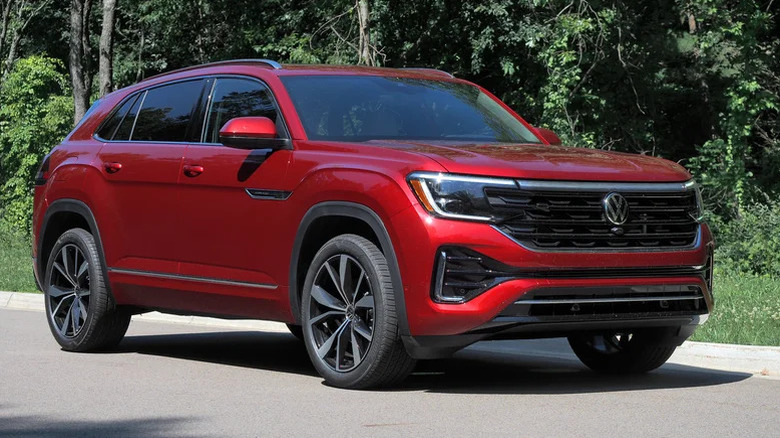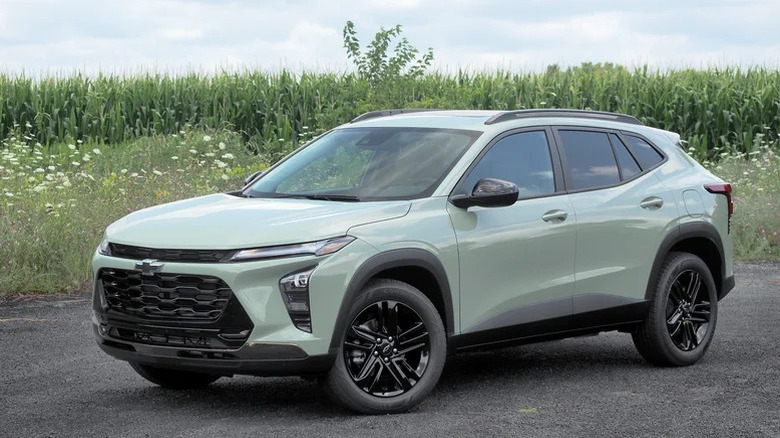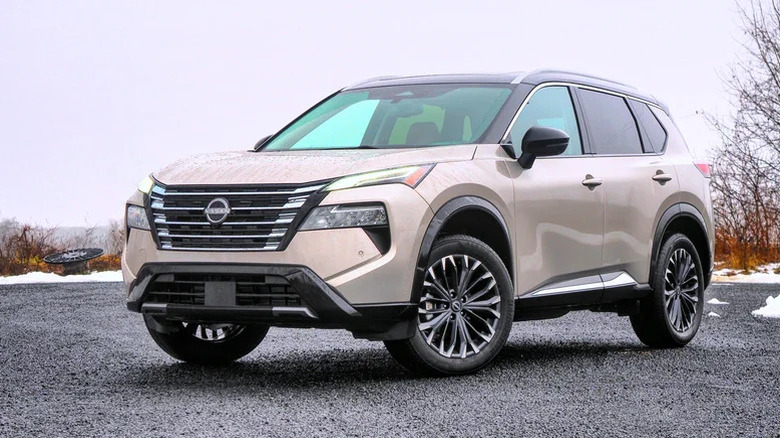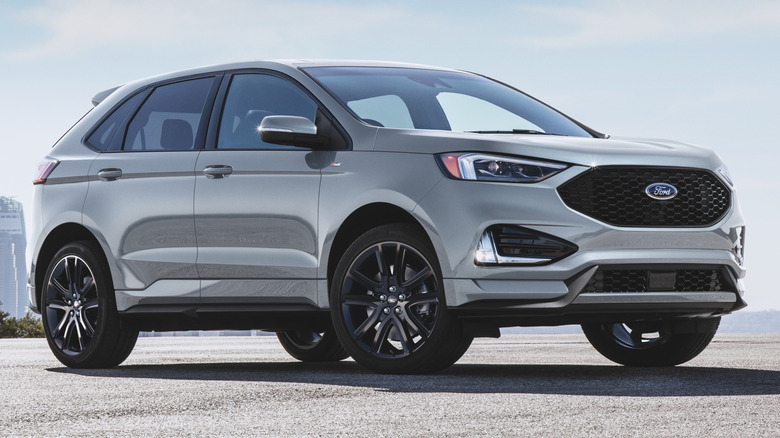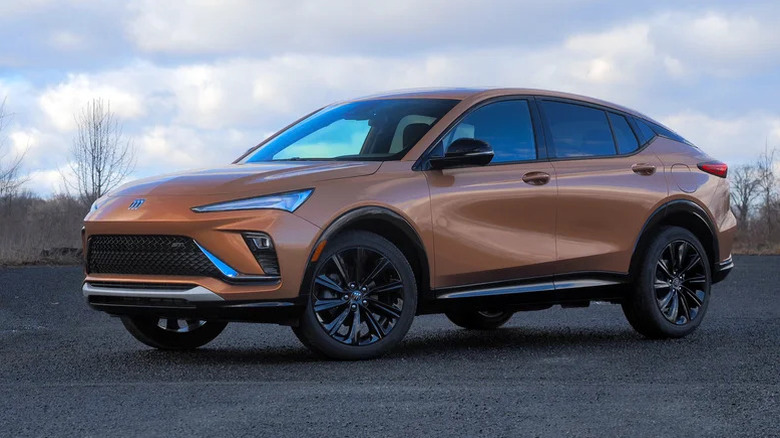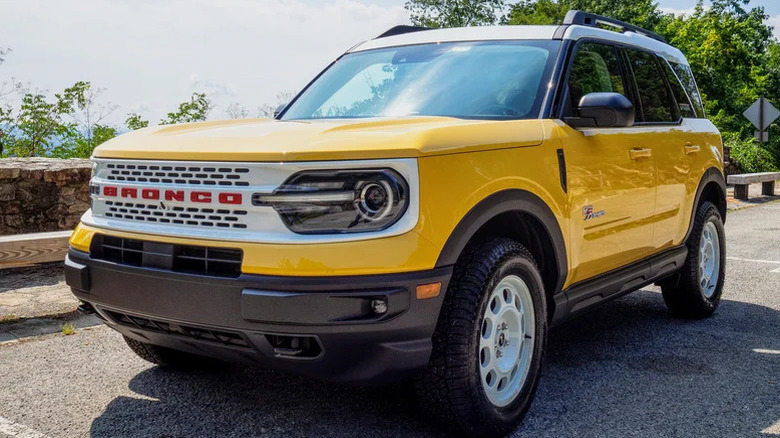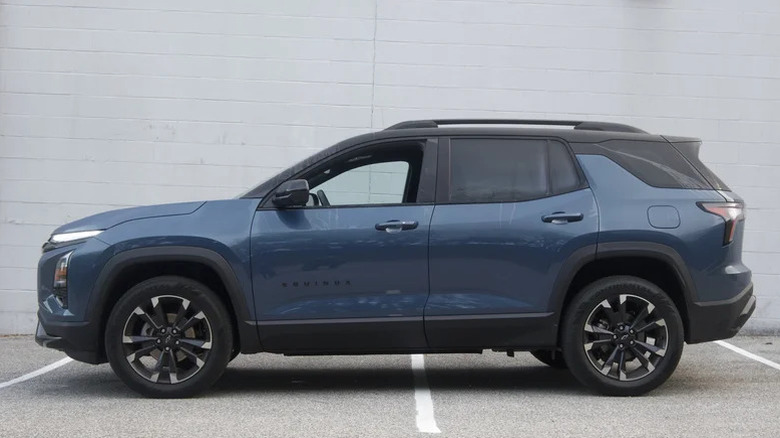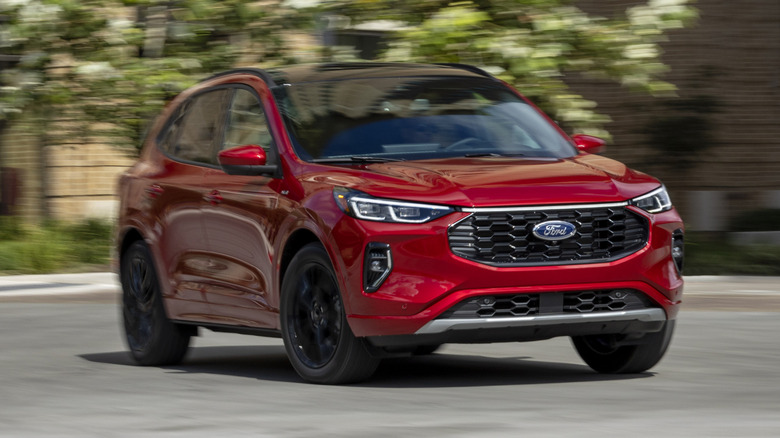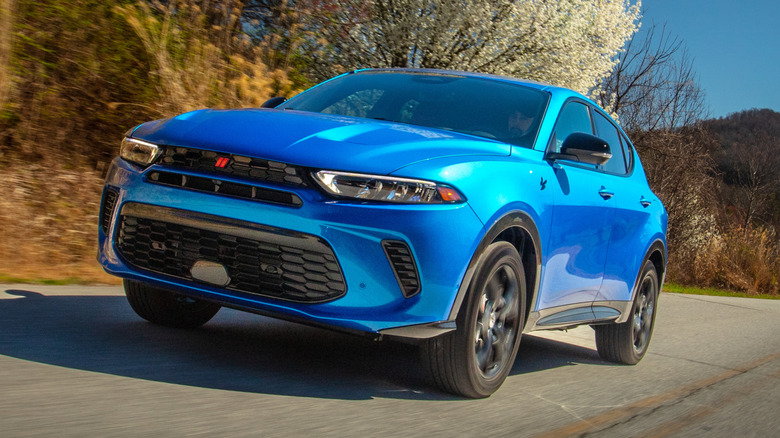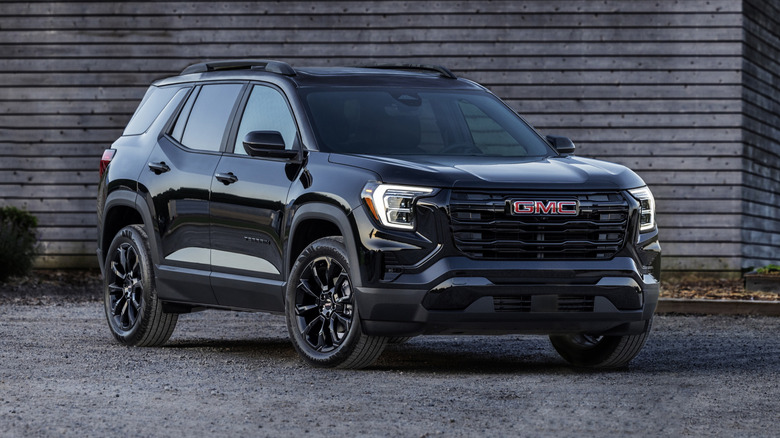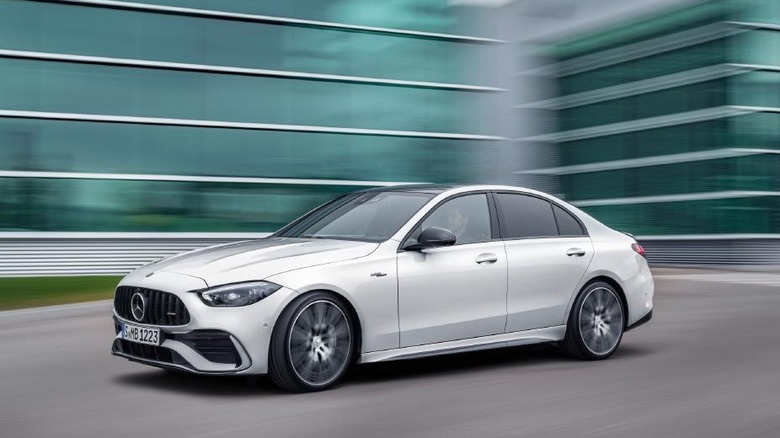12 Big Cars With Surprisingly Small Engines
The popular saying goes that, "there's no replacement for displacement." However, that's never been less true than in the modern car market. Many of today's most popular cars feature smaller engines than their predecessors, with advancing design, the near-ubiquity of turbocharging, and hybrid technology all contributing to those shrinking displacement figures. As a result, many modern cars are significantly more efficient than before too, leading to reduced emissions and reduced bills at the gas pump.
While the news of a small engine powering a large car is no longer the novelty that it once was, there are a few models that stand out from the rest as having particularly small engines given their sizes. These popular models all fit that description, offering smaller displacements than their rivals despite their generous sizing for their respective segments. Each has an engine displacement of 2.0L or lower, although you might not guess that at first glance by looking at them.
Honda CR-V
The latest generation of the CR-V was launched for the 2023 model year, and with it, a revised range of engines was unveiled. The smallest of those was a 1.5L turbocharged four-cylinder, which forms part of the brand's L-Series family. It's shared with a number of other popular models including the Accord and Civic, with Honda reportedly producing almost four million examples of the L-Series family since it was first introduced in 2001.
The current generation engine in the CR-V has evolved significantly from the original, having benefited from more than two decades of further development. A key reason Honda chose to use it for the CR-V despite the size of the car is its efficiency — it's designed to be as frugal as possible, although it's still bested by the CR-V Hybrid in terms of EPA figures, even though the hybrid has a larger 2.0L four-cylinder engine. Nonetheless, the 1.5L engine's 30 mpg combined is nothing to sniff at, and it gives the car more than 400 miles of range on a single tank.
Volkswagen Atlas/Atlas Cross Sport
VW's mid-sized Atlas and Atlas Cross Sport SUVs both feature one of the smallest engines in their class, with a turbocharger 2.0L four-cylinder engine shared across the two sister models. The engine is new to the latest generation, with the outgoing VW SUV featuring a V6 instead. Downsizing hasn't had much of an effect on overall power — in fact, torque is slightly increased over the previous generation, although the four cylinder loses a few horses compared to the old powertrain.
After spending some time with the Atlas Cross Sport, SlashGear found it to be generally solid value for money, even if the more athletic styling of the model cut down on some of its practicality compared to the Atlas. It is both more efficient and boasts fresher tech than the previous generation, although the reviewer found the latter to be unintuitive to use compared to its rivals. Overall, the Atlas fell slightly short of being special, although its new, smaller engine wasn't to blame for that.
Chevrolet Trax
While it's far from the biggest car here in terms of overall size, the Chevrolet Trax still manages to surprise given that its engine displacement is among the very smallest of any car currently offered on the American market. Under the hood sits a turbocharged three-cylinder engine with just 1.2L of displacement, but despite that, it's not sluggish to drive. SlashGear found its power to be more than adequate for urban and suburban driving, although unsurprisingly, it was less at home on the highway.
The current generation Trax debuted for the 2024 model year, and brought with it some welcome updates. New safety tech and a larger infotainment screen shouldn't be taken for granted at this price point, and despite its low starting price, the refreshed cabin doesn't look too cheap. However, despite the Trax's tiny engine, its fuel economy remains middling, with SlashGear's real-world testing coming up a few mpg short of the officially claimed 30 mpg combined rating.
Nissan Rogue
The Rogue is Nissan's entry into the competitive compact SUV market, and like all of its rivals, buyers expect it to deliver on both performance and efficiency. The 1.5L turbocharged three-cylinder powering the current Nissan Rogue does an admirable job of balancing both, feeling sprightlier to drive than its displacement figures might suggest. In front-wheel-drive form, it's also impressively efficient, with a combined 33 mpg rating.
A new, off-road oriented Rogue Rock Creek trim launched for the 2025 model year, but despite the toughened looks, the engine remains unchanged across all trims. It's mated to a continuously variable automatic transmission, which tries its best to make as little fuss as possible during everyday driving. A Sport mode is available, but given the limited power on tap, it only results in a minor personality change for the car. Nissan's SUV might have plenty of rivals, but even if it doesn't have an engine as large as many of them, it manages to match up to the rest.
Ford Edge
After a few years on sale without any significant updates, the Ford Edge was discontinued earlier in 2024. As of this writing, it remains available to buy new through existing inventory at dealers. Top-spec variants of the Edge are available with a 2.7L V6, but base-spec variants receive a smaller 2.0L EcoBoost turbocharged four-cylinder engine. Its relatively short lifespan can be put down to Ford's electrification plan, with the automaker opting to retool the assembly plant where it was produced to instead produce electrified Super Duty Trucks.
There's no word yet on whether the Blue Oval is planning to launch a replacement SUV in its lineup, but if it does, it may well be a hybrid or all-electric. The 2.0L engine in the current Edge is a small engine given the size of the SUV, but it's not the smallest engine Ford currently offers in the U.S. Instead, that honor goes to the 1.5L three-cylinder that can be found in both the Bronco Sport and the Escape.
Buick Envista
The Buick Envista shares both a platform and a powertrain with the Chevrolet Trax, but it's no badge-engineered clone. The Envista's styling is drastically different from the Chevy, and arguably, it's the better looking of the two. It also offers a distinct cabin, although there are plenty of elements that are clearly borrowed from other GM models. That's no bad thing either — SlashGear found the larger infotainment touchscreen to be particularly impressive given the Envista's price point.
There are some compromises that Buick had to make to keep the car affordable, and its 1.2L turbocharged three-cylinder is an obvious one. There's no hiding that similarly sized crossovers will provide plenty more poke, but they'll also come with considerably larger price tags. Even a top-spec Envista can be picked up for under $30,000, making it an attractive entry point to the Buick range assuming buyers don't need the added power and all-weather capabilities that the brand's pricier SUVs offer.
Ford Bronco Sport
It might be the smaller sibling to the full-size Bronco, but the Ford Bronco Sport is still generously sized for its segment. Considering that a significant chunk of its appeal comes from its all-terrain capabilities, the Bronco Sport has a smaller engine than many might assume. Under the hood of lower trims sits a 1.5L turbocharged three-cylinder engine, which sounds impressive given its size but leaves the SUV feeling adequately peppy rather than sporty.
Of course, the main appeal isn't the car's sportiness, despite what its name might imply. It is, instead, a smaller, more civilized, and more affordable alternative to the full-size Bronco. It's easy to assume that the 1.5L engine was chosen primarily for its efficiency, but in fact that's one of the few areas where the Bronco Sport doesn't quite hit the mark. SlashGear's reviewer averaged 21.2 mpg, considerably short of the best in the segment and a little underwhelming considering the small engine. For those who need an extra bit of power, Ford also offers a more potent 2.0L EcoBoost turbocharged four-cylinder for higher trims.
Chevrolet Equinox
Balancing affordability, space, and everyday practicality, the Chevrolet Equinox is a big hit with buyers for a reason. However, it's not without its imperfections, with several of those revolving around the car's 1.5L turbocharged four-cylinder engine. It's a small engine given the size of the car, and so it has to work relatively hard when you put your foot down. That results in a soundtrack that our reviewer notably referred to as, "lean[ing] more towards agricultural."
It's not very efficient either, and trails its similarly-sized non-hybrid competitors. Buyers looking for an alternative powerplant are out of luck, as Chevy only offers a single engine option across all trims. However, overlook the engine's limitations and the Equinox is a solid choice as a hassle-free daily driver, with the fresh batch of infotainment and safety tech helping make what was already an attractive proposition even more competitive with its rivals.
Ford Escape
Offering a 1.5L turbocharged three-cylinder engine, the Ford Escape has enough space for a small family, but buying one won't break the bank. It's not quite as roomy as the Edge, but unlike the latter, it remains in production, at least for now. Rumors have emerged that the Escape might also eventually be heading for the chop, with an EV replacement on the way as soon as 2026. That means that Ford's 1.5L EcoBoost engine might become a much rarer sight in the near future, although it still remains the base option in the Bronco Sport.
Ford has dialed back its EV rollout plans in recent months, citing lower than expected demand, and the automaker has kept its revised strategy mostly under wraps to date. Whether that strategy involves a car with the Escape nameplate — electric or not — remains unknown, but either way it seems the current 1.5L EcoBoost Escape won't be around for too much longer.
Dodge Hornet Hybrid
The Dodge Hornet has not had the easiest of launches. Early buyers reported a significant number of quality problems with their cars, mostly regarding its electrical systems, while multiple safety recalls threaten to tarnish its image permanently. SlashGear reported its own set of electrical gremlins while testing the Dodge Hornet Hybrid in 2023, although thankfully none of our problems concerned its hybrid powertrain.
It's this powertrain that allows the Hornet to have such a small engine while maintaining a competitive power output. The electric motors work in tandem with the engine to boost acceleration without denting efficiency, and the battery gives the car up to 32 miles of all-electric range, per Dodge. That all helps make the Hornet's engine feel a lot less little, and in fact leaves it more potent than the base-spec Hornet's 2.0L unit. However, all that matters less when the car itself has given owners so many reasons for concern, with the Hornet's ongoing reliability issues overshadowing the appeal of its clever powertrain and eager driving dynamics.
GMC Terrain
For the 2025 model year, the GMC Terrain received an update to keep it competitive against its ever-changing field of rivals, but the same 1.5L turbocharged four cylinder engine from the old car remains unchanged. Its platform and powertrain are shared with the Chevrolet Equinox, and much like the Chevy, the GMC looks larger and tougher than buyers might expect given its engine size.
It takes a lot to stand out in the compact SUV segment, and the Terrain tries to do just that with its combination of updated style and a sleeker interior. New safety tech is also offered, although the latest Terrain is lacking the improved efficiency numbers that many of its rivals offer. An EPA-estimated combined mpg figure of 27 mpg for the front-wheel drive Terrain isn't bad, but it's certainly not class leading. Opting for all-wheel drive drops that figure down further to just 25 mpg combined.
Mercedes-AMG C43
While the Mercedes-AMG C43 doesn't have the upright stature or generous cabin proportions as many of the other big cars here, it's still no Smart car. Plus, it's a full-fat performance AMG model, and historically, that has invariably meant that a larger, more powerful engine will be found under the hood. However, even AMG isn't immune from the stricter emissions regulations that the modern market is bound by, and that's meant that its screaming V8 engines and brawny six-cylinders are reserved for its largest models.
The latest generation of the C43 receives a 2.0L turbocharged four cylinder engine, replacing the outgoing car's twin turbocharged V6. Yet, it's still more powerful than before, producing 402 horsepower and assisted by a mild hybrid system that can give a temporary boost of 13 additional horses. There was, unsurprisingly, plenty of controversy surrounding this new, downsized powerplant, but its introduction was arguably inevitable given the changing state of the market. Its engine might be small, but it doesn't compromise on power — ironically, it packs enough punch that it could even feasibly be put in a bigger AMG should the brand choose to do so in the future.
